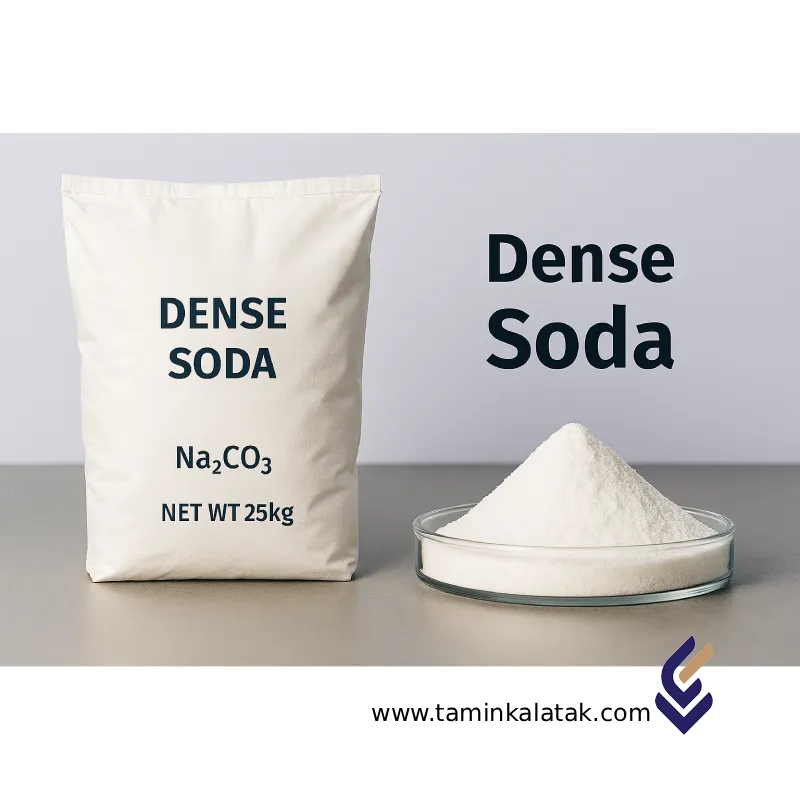Dense Soda
Dense Soda, also known as Heavy Sodium Carbonate or Na₂CO₃, is an alkaline inorganic salt that appears as a white, odorless, coarse-grained crystalline solid.
Unlike Light Soda Ash, the dense grade has higher bulk density and larger particle size, making it suitable for processes that require greater physical strength or slower dissolution rates.
Chemical Structure of Dense Soda
-
Chemical Name: Dense Sodium Carbonate
-
Chemical Formula: Na₂CO₃
-
Structure: Ionic crystalline lattice composed of Na⁺ and CO₃²⁻ ions
-
CAS Number: 497-19-8
-
EC Number: 207-838-8
-
Molecular Weight: 105.99 g/mol
Physical and Chemical Properties
| Property | Description |
|---|---|
| Physical State | White crystalline solid, coarse granules |
| Apparent Density (20°C) | Approx. 1.04 g/cm³ (depending on compaction) |
| Bulk Density | 1.0 – 1.2 g/cm³ (typically 1.1 g/cm³) |
| True Density | 2.53 g/cm³ |
| Boiling Point / Decomposition | Decomposes at high temperature to Na₂O and CO₂ |
| pH (1% aqueous solution) | Approximately 11.4 – 11.6 |
| Odor | Odorless |
| Corrosiveness | Non-corrosive under normal conditions; alkaline and irritating to skin and eyes |
| Chemical Stability | Stable under normal conditions; tends to cake when exposed to moisture |
Applications of Dense Soda
Glass Industry
-
One of the three primary raw materials in glass manufacturing (along with silica and lime)
-
Reduces the melting point of silica and improves molten glass properties
Water Treatment
-
Used to adjust pH and reduce temporary hardness
-
Neutralizes acids and enhances precipitation efficiency
Detergent Manufacturing
-
Used in industrial laundry powders to increase alkalinity and remove hardness ions
-
Enhances the cleaning efficiency of surfactants
Pulp, Paper, and Textile Industries
-
Used for recovery of cellulose fibers and pulp cleaning
-
Controls acidity in bleaching and dyeing processes
Metallurgical and Petrochemical Industries
-
pH regulator in metal extraction processes
-
Alkaline cleaning agent or pH stabilizer in chemical plants
Advantages of Dense Soda
-
Higher bulk density → lower consumption compared to light soda ash
-
Reduced dusting → safer and cleaner handling and storage
-
High thermal and chemical stability
-
Cost-effective and readily available on an industrial scale
-
Compatible with a wide range of industrial systems
Disadvantages of Dense Soda
-
Strongly alkaline → requires care to avoid skin and eye contact
-
Reacts with acids → generates heat and releases CO₂ gas
-
Hygroscopic → absorbs moisture, leading to caking if improperly stored
-
Must be stored in dry conditions, away from acids and moisture sources
Safety and Handling Information
-
GHS Classification: Irritant – H319 (Causes serious eye irritation), H315 (Causes skin irritation)
-
Skin Contact: Use rubber or nitrile gloves
-
Eye Contact: Use safety goggles or face shield
-
Dust Inhalation: Wear filtered respirator masks in confined or dusty areas
-
Packaging: Multi-layer moisture-resistant bags, typically 25 kg or 50 kg
-
Storage Conditions: Store in a cool, dry, well-ventilated area, away from acids and humidity
-
Transportation: Non-hazardous solid; standard dry cargo classification
Dense Soda
| Products | Chemical formula | CAS number | Grade | Solubility in water | Melting point | Density (at 20°C) | Physical appearance | Vapor pressure |
|---|---|---|---|---|---|---|---|---|
| Sodium Carbonate – Dense Soda Ash | Na₂CO₃ | 497-19-8 | Industrial Grade, Analytical Grade, Food Grade – E500(ii) | About 215–220 g/L (high and alkaline) | 851°C | 2.53 g/cm³ (True density – bulk density 1.0–1.2 g/cm3) | Solid, white crystalline, coarse-grained, odorless | Practically negligible at ambient temperature |







